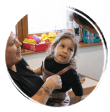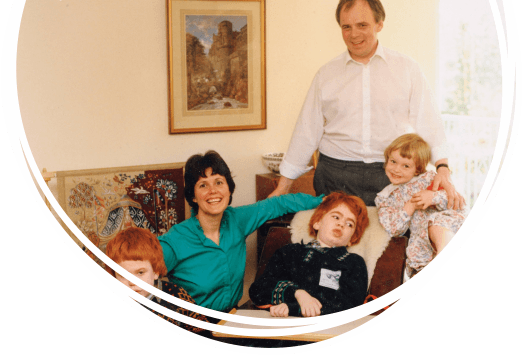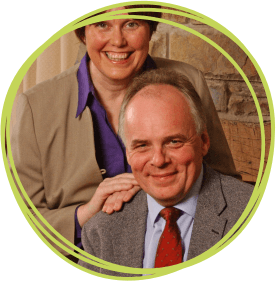
They had little money in the bank and no wealthy backers. Just a dream to build a children’s hospice and a remarkable story that would unite the whole of the South West.
But a ‘bonkers’ idea born from a restless night’s sleep led to the founding of Children’s Hospice South West by Eddie Farwell and his late wife Jill in 1991 – and 30 years later in 2021, the charity is celebrating an incredible journey that has touched the lives of thousands of people across the peninsula.
By the late 1980s, Eddie, Jill and their three young children had become very familiar with the long drive from their home in North Devon to Helen House in Oxford, then the world’s first children’s hospice. The ribbon was still to be cut on the A361 North Devon Link Road but the arduous four-hour trek was always one worth making for the haven that awaited them at the end of it.

The couple’s two eldest children, Katie and Tom, had both been diagnosed with a rare degenerative genetic disorder that brought with it the devastating prospect that they would not reach adulthood.
In Helen House, the family had found a place where they could recharge their batteries three or four times a year and receive support from people who knew and understood their situation. In particular it was a haven for their well daughter Lizzy.
“The place had been set up to look after whole families, not just children during the acute phase of illness; they became our extended family,” recalls Eddie, whose lightbulb moment actually happened during a stay at the hospice at beginning of 1990.
I woke up one night and said to Jill that we should build a children’s hospice for the South West of England.
"Jill looked at me as though I was mad and told me to go back to sleep. But extraordinary circumstances produce extraordinary responses and from that bonkers statement an idea grew because we knew that there were many hundreds of families in the West Country who should also have the opportunity to experience the benefits which we were receiving at Helen House.
“We wanted to build something akin to what we’d experienced in Oxford for the whole of the South West, from South Gloucestershire down to the Isles of Scilly, and we sought support from all over the place. I can remember going to a meeting with some senior NHS figures in Bristol and I think they thought ‘well, if these people want to go ahead and do it, let them do it!’.
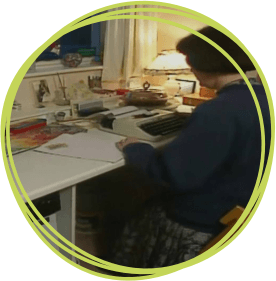
“At the meeting, somebody asked the question ‘where are you going to build it’ and I said, ‘we’re going to build it in Barnstaple’. Well, you could have heard a pin drop.
“They asked why not Bristol but I think they understood that here we were in this vast rural tract of the country which is poorly served in many ways. And if you put a pin in Gloucester and a pin in Penzance it bisects the West Country roughly between Tiverton and Barnstaple.”
In taking on the project, the Farwell’s knew it would change their lives but Eddie admits they underestimated the toll it would take on them travelling the length and breadth of the South West to spread the word and raise the £1million needed.
Eddie was working full-time at Devon Social Services while Jill looked after the children at home and the couple did what they could in their spare time. They started fundraising in the laundry room of their home in the village of Marwood and spent days, evenings and weekends on the road with printed leaflets to hand out to people they were talking to about the project.
We had no money in the bank and no wealthy backers so we did the only thing we could do – go out and tell our story to anyone who would listen.
After a public launch in North Devon in May of 1991, two-to-three-thousand-pounds was coming through the couple’s front door every week. And by February 1992, after the appeal was launched regionally, there was between £20,000 and £30,000 coming in a month.
“It was remarkable and difficult to explain because the South West is a bit tribal,” recalls Eddie. “What I can say is that whether you lived in Cornwall or Bath, South Somerset or the South Hams, wherever you were, people were united by the story of there being hundreds of children who could benefit from a children’s hospice. It transcended those geographical boundaries and the tribalism that exists. And that was absolutely remarkable.
“One of the questions we were often asked was did we fear failure? And no we didn’t, perhaps we should have if I’m honest. We always said that if we’re not going to be successful, somebody else can take the baton from us and that would be the way to do it.”
Little Bridge House
By early 1992, the groundswell of support for the project led the Farwells, together with the charity’s trustees, to produce a working model of how the hospice would look. They also sought planning consent to build on some Church of England Glebe land in Fremington, near Barnstaple.
Little Bridge House was to be built without incurring any debts, and with money in the bank to run it after it opened. When the hospice opened its doors to families in
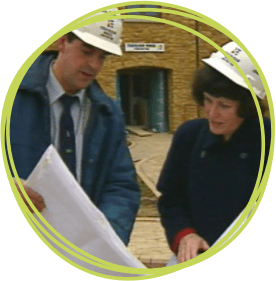
September 1995, despite the elation of realising their dream, it was a day of mixed emotions for the Farwells. They were without Katie, who had died at Helen House in November 1991, and Jill had been diagnosed with breast cancer in early 1995.
“It was a time of great joy and great relief but we were pretty exhausted,” recalls Eddie. “Jill was a magnificent fundraiser who led charity at that point and it was a great joy to have her well enough to be at the opening.
“We were in touch with many, many families who were waiting for us to open and it was a joy just to hear people’s comments. One of the most memorable things a mother said to me when she visited the building came when she sat on the bed and sobbed and said ‘all this for us?’.
I said ‘yes, all this for you because this is what your fellow citizens in communities throughout the South West want for you and your family’.
"It was very powerful and if I was to highlight anything that anyone has ever said to me during the course of the 30 years, that is probably the most powerful.”
The next step for the charity was to sustain the running of Little Bridge House – a challenge that the community continued to take to its heart.
“I feel a tremendous sense of humility at how people were able to support us and give what they could from all over the peninsula,” says Eddie. “Because we didn’t know anybody who had vast wealth, our fundraising basis was built up from men and women and boys and girls giving what they could. Rather than having to rely on big donors, we had an enormous number of people who regularly gave to us, which actually made us quite a strong organisation.
“It’s that community strength that not only underpins the work that we do, but also underpins our financial sustainability, although big donations should I say are always welcome!”
Charlton Farm
Little Bridge House became virtually oversubscribed towards the end of the 1990s and the charity began to consider the possibility of there being a second children’s hospice in the region.
“We initially had the view that it shouldn’t be us, that maybe someone else would like to do it,” recalls Eddie. “Tom had died in 1998, Jill was struggling with her illness, I was still working and we had our young daughter Lizzy to look after. We had quite a considerable load upon us and our trustees were unsure about whether we should do anything else. But anyway, we looked around for other people who might be able to take on a project and the obvious place to do that was in the greater Bristol area because that was where our greatest demand was.”
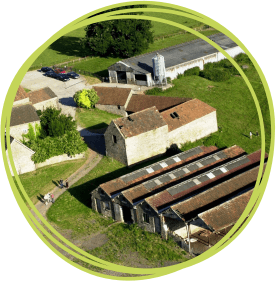
Nobody came forward. So when a long-time supporter introduced two retired couples from Bristol who wanted to give the charity a substantial sum of money to help it expand into the area, plans for a second hospice soon began to take shape. Their incredible encouragement signalled the start of a challenging search for four acres of level land in North Somerset in 2002-03, at the height of the property boom.
“Prices were sky high and we looked and looked and looked,” recalls Eddie. “Jill was up and down the M5 like a fiddler’s elbow looking at sites and came up with nothing really. Then one day we rang a land agent whose name had been given to us and he said he had a farm that used to be part of the Lord Wraxall’s estate at Tyntesfield. We saw the place on the Tuesday, the trustees came up to see it on the Wednesday, we put in an offer on the Thursday, which was accepted on the Friday and completed in double quick time.
“What we ended up buying was a 100-acre farm in a valley, which was absolutely ridiculous but it was meant to be. We had the money to buy the land because of the people’s generosity and I have to say it is the most magnificent site; it’s just five miles from Clifton Suspension Bridge and you could be in a different world. And I know from what families who travel out to us from inner city Bristol think of being there.
“The Bristol area wasn’t part of the plan; it was circumstantial and it came through that generosity and the force of community spirit that was there in the area and people’s general love for children and vulnerable people.”
Little Harbour
The charity officially launched an appeal at the beginning of 2004 to raise the money needed to build and equip the hospice and Charlton Farm subsequently opened in 2007. Jill sadly did not see the hospice open as she lost her cancer battle shortly after the foundation stone was laid in 2004. But she and Eddie, as well as the charity’s then chair of trustees, Trevor Lloyd, had already privately thought there would need to be a third hospice due to the geography of the South West.
Eddie recalls: “When we completed Charlton Farm in 2007, we still had money in the bank to run both hospices. People’s generosity was unbelievable, so we launched the Precious Lives Appeal to build our third hospice in Cornwall later that year.
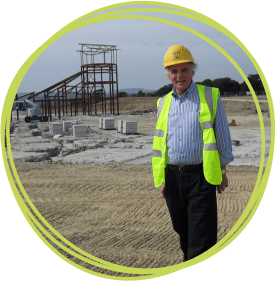
“The venture happened a little bit earlier than we’d anticipated but we received an incredible amount of support from that county; the Cornish appeal was phenomenal. We launched in 2007 and despite the world banking crisis in 2008, Little Harbour opened in St Austell in 2011.
“For me, it was an incredible experience. But something happened to the charity at that point; we became truly South Western with our three areas of activity. And I think that has really strengthened us as an organisation, and that is particularly the case as we enter our 30th year.”
Jill and Eddie both received MBEs for their services to palliative care, Jill in 2002 and Eddie in 2015. Eddie recalls his memorable encounter with the Queen at Windsor Castle and reflecting on the reasons he was there.
“It was a tremendous honour but it was all because of Katie and Tom and many other hundreds of children like them, and also because of those tens of thousands of people who have made it possible,” he says.
And it is only thanks to those people that wherever families live in the South West, children’s hospice care is available within an hour-and-a-half drive. The charity currently supports more than 500 children with life-limiting conditions and their families and in 2020, it adapted its care during the pandemic to ensure Covid-safe support wherever and whenever families need it, including in the hospices, and for the first time ever, in families’ own homes. The charity needs around £11m a year to run its hospices, and around 85 per cent is raised through voluntary donations.
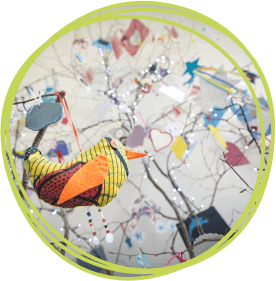
“We are providing a specialist medical service and it’s about keeping families together and accompanying them on an often long, long journey in many, many cases,” explains Eddie.
“Many more children are living with significant levels of disability and the technology that has developed to support them means that the care we provide is not only more needed, but it becomes more technical. The numbers have grown tremendously, the complexity has grown tremendously, and it is a very expensive service to run.
“We are aware of the economic impact of this wretched pandemic and its long-term effects on our community but CHSW is a stable organisation and our magnificent supporters have been key to that and we are sure they will continue to rally for us in our 30th year.
It has been a tremendous journey and so many children and families have been helped along the way, work would not have been possible without the continued faithfulness and generosity of people all over the South West.
“Whether it’s Cornwall, Devon, Somerset, Bristol, South Gloucestershire or Bath, wherever it might be, we are here thanks to the generosity of the people of this region and the love that they exude for children and families where the child is going to die before adulthood.
“It shows you what the power of people coming together can achieve and we are inviting everyone to join with us in 2021 and celebrate our wonderful milestone, and all that they have helped us achieve. The charity’s strapline is ‘making the most of short and precious lives’, so please join us in continuing to do just that.”
There are lots of ways people can support CHSW during its 30th year and every penny raised will make a real difference to families in 2021. Get involved or find out more, here


